 November 2023
Andy Cutko speaking to the attendees of the Mt Battie Road rededication ceremony.
All I could see from where I stood
Was three long mountains and a wood;
I turned and looked another way,
And saw three islands in a bay
So began the poem ?Renascence,? by Camden resident Edna St. Vincent Millay in 1917. Her words describe the iconic view of the mountains and the sea from atop Mt. Battie. (St. Vincent Millay later earned the Pulitzer Prize for Poetry in 1923.) While St. Vincent Millay would have hiked up Mt. Battie, that view is now enjoyed by thousands of visitors each year thanks to a road built to the summit in the 1960s.
I recently had the privilege of joining Commissioner Amanda Beal and several others on a lovely fall day on Mt. Battie for a ribbon-cutting ceremony commemorating a major renovation of the road to the summit. This renovation, completed by L.G. Whitcomb and Pine Tree Engineering, is one of dozens of state park improvement projects funded by $50 million from the Maine Jobs and Recover Plan. With that funding, we are implementing a vision for state parks that extends far beyond the horizon.
~?Andy Cutko, Director, Maine Bureau of Parks and Lands
Photos - top to bottom and left to right: Ribbon cutting by DACF Commissioner Amanda Beal - in the photo left to right are Matt Hamilton, Ryan Kerr, Greg Whitcomb, Commissioner Beal, Lyndon Whitcomb, David Rodrigues, Representative Vicki Doudera, and Andy Cutko. In the photos below are attendees of the ceremony, speakers Park Manager Charlene "Sunshine" Hood and Coastal Mt. Land Trust Stewardship Director Ryan W. Gates, singer Hayden Sears, and visitors on the summit of Mt. Battie.
Editor's Note: Listen to Edna St. Vincent Millay reading Renascence.
Top of page

Patty MacAlister started her State employment with the Bureau of Parks and Lands (BPL) at Peaks-Kenny State Park as a Customer Representative Assistant in August 2006. She worked two seasons at Peaks-Kenny before accepting a year-round position as an Office Assistant at Dorothea Dix (DDPC) and quickly moved up to a position with the Department of Labor as an Office Associate. In August 2012, she came back to BPL when she accepted an Office Associate II position at the Northern Region Parks office in Bangor. Sadly, for us, she retired in September 2023.
Patty set an example for everyone in the way she pushed to resolve issues. Her firm but educational and often humorous approach to problem-solving resulted in effective communication, conflict resolution, and friendship with internal and external customers. She developed a reputation as an excellent problem-solver, especially with park managers. Patricia helped educate staff regarding the multiple and rapidly changing COVID-19 guidelines and the myriad of other paperwork and system changes at the Regional Office and all Northern Region Parks.
Patty will be greatly missed!
~ Matt Hamilton,?Northern Parks Regional Manager
|
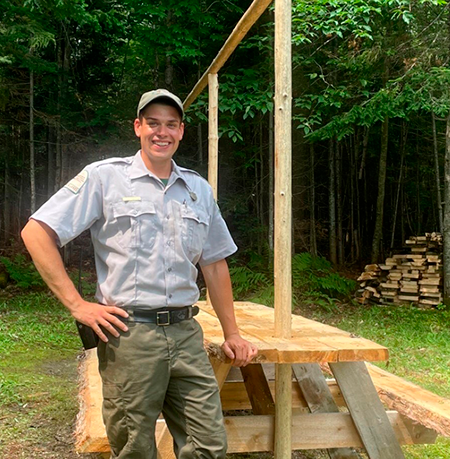
Cameron McIntosh, Assistant Ranger in the Allagash Wilderness Waterway, recently received accolades from visitor Jim Lynch after he and three other paddlers finished an eight-day canoe trip on the waterway. Jim wrote how grateful he was to meet Cameron when they had the hurricane at their backs and a stiff north wind contributing to challenging conditions. Cameron "welcomed us to his [ranger] station, shared the latest weather, introduced us to the museum, and ferried us up the river." He was "very helpful in getting us and our gear back on the water so we could reach better campsites in time for the storm, and [on the way] introduced us to the artist in residence program. We left him knowing that he would be watching out for us through the storm and to [our] take out. He is an outstanding ranger, and I cannot think of a better representative of the waterway and of Maine." Jim plans to return to the Allagash Wilderness Waterway for more paddling adventures in this "beautiful and wild part of the world."
Cameron, we are proud of your service, and thank you for being part of the Allagash Wilderness Waterway team!
~ Mark Deroche, Superintendent of the Allagash Wilderness Waterway
Related Resources:
Top of page
|
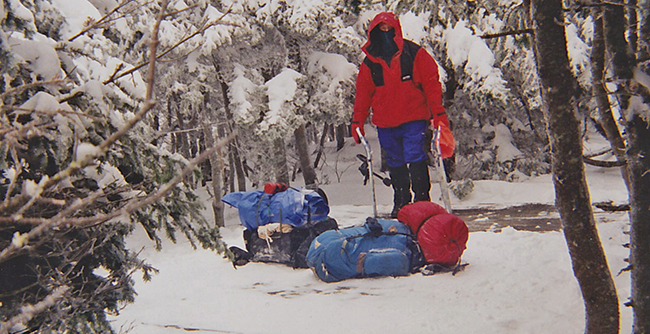 |
Winter camping, with tents only, is available beginning on December 15 at select Maine State Parks, and on Public Lands. If you are new to winter camping, plan to camp at a Maine State Park first. These locations provide the challenge of winter camping and offer a good range of front country and remote sites to test your skills. Even for the experienced it is good to start the season off with an easily accessible location as a test run before heading out to more challenging terrain. Highly experienced winter campers, or those who will be led by a Registered Maine Guide, are ready for the remote settings found on Maine's Public Lands.
View the Winter Camping video and see all the details on our Off-season and Winter Camping webpage.
~ Jocelyn Hubbell, Interpretive Specialist and Rex Turner, Outdoor Recreation Planner
Megunticook Cabin at Camden Hills State Park.
The Megunticook Cabin at Camden Hills State Park is available for rent year-round. It is a winter camping tradition for many park visitors who want to avoid tent camping but are looking for a rustic experience during multiple-day cross-country skiing or snowshoeing adventures at the park. Accessible on foot or by snowmobile, the cabin offers visitors camp-style bunks that sleep six, a wood stove for heat, a rustic fieldstone fireplace, and the opportunity to step back in time to a simpler way of life - there is no electricity or running water. All the details and the park phone number for reservations are in the Megunticook Cabin brochure.
~ Charlene "Sunshine" Hood, Manager, Camden Hills State Park
Top of page
Aerial image of Deboullie Public Land.
Students from Fort Kent SAD 27 got hands-on and in the field during a recent two-day camping trip at Deboullie Public Lands. The adventure, a thirty-year tradition, brings science lessons alive, builds outdoor skills, and may even inspire students to become outdoor professionals and scientists. It is always exciting to see people out on the lands stewarded by the Maine Bureau of Parks and Lands (BPL), especially when outdoor education is taking place. Kudos to all the students, teachers, and volunteers who are keeping this tradition alive! And thank you to WAGM TV Reporter Megan Waceken who covered the trip. View the students at Deboullie and read Megan's story.
~ Jacob Guimond, Northern Region Public Lands Manager
Top of page
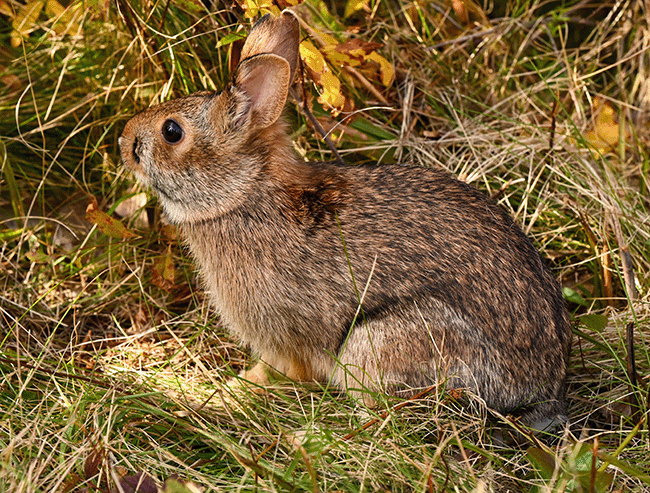
The results are in! Surveys conducted this past winter continue to show an increase in the population of New England cottontails and an expansion of their range. Surveys are conducted statewide within the species? range and include State Parks. The surveys are coordinated by the Department of Inland Fisheries & Wildlife (MDIFW) and completed by trained staff and an intern who follow designated transects through the species? habitat. All fecal pellets along the transect line are collected for genetic analysis, which distinguishes between New England cottontails and their non-native relative, the eastern cottontail. It even identifies individual cottontails! This genetic work is done in partnership with the University of New Hampshire and the University of Rhode Island.
Kettle Cove State Park continues to be a stronghold for our native New England cottontail. An abundance survey at Kettle Cove in 2023 documented 32 individuals, up from 15 and 17 in 2018 and 2019, respectively. This increase is despite a carefully planned removal of five individuals in spring 2022 which were subsequently released at Scarborough Marsh Wildlife Management Area. Following those 2022 releases at Scarborough Marsh WMA, an abundance survey in 2023 documented 14 individuals there, including some that were born on site! A 15th individual carrying a tracking collar was also present but wasn?t detected with fecal pellet genetic testing. This is extraordinary news!
In Maine, New England cottontails were known to be present in 21 patches in 2018. By 2023, that number has grown to 45 known occupied patches thanks to the efforts of many partners, conservation organizations, and private landowners.
While we can celebrate these successes, our work is not done. New England cottontails are highly susceptible to winter mortality and predators, and they are often outcompeted by the eastern cottontail, a species not native to Maine that continues to be detected during surveys. A survey at Crescent Beach State Park in 2018 detected two hybrids of a New England cottontail and eastern cottontail. The 2023 survey detected a full-blooded eastern cottontail at Crescent Beach State Park. This is disappointing for all involved in New England cottontail conservation, and it?s not the only site where this has occurred in recent years. These eastern cottontails were likely brought to the area by people, either purposefully or incidentally, and they can quickly outcompete New England cottontails. The two species are nearly indistinguishable, even for experts, so under no circumstances should a cottontail be relocated without prior consultation with MDIFW.
To protect New England cottontails while you?re enjoying State Parks, please keep all pets leashed and stay on marked trails and in developed recreation areas.
Related Resources:
~ Sarah Spencer, BPL Biologist & Cory Stearns, MDIFW Small Mammal Biologist.
(New England Cottontail photo courtesy of MDIFW.)
Top of page
|
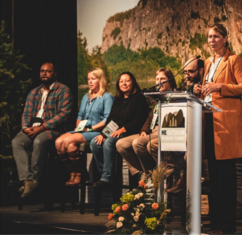
The three-day Maine Outdoor Economy Summit (MOES) is an event to connect, learn, and collaborate to focus on the shared vision of advancing Maine?s outdoor recreation economy. It is a forum for professional development, ideation, and discussions on essential topics impacting Maine?s outdoor industry in the areas of economic development, workforce, access, and equity. Learn more, view the agenda and register to attend.
~ Courtesy posting for Carolann Ouellette, Director, Office of Outdoor Recreation, Maine DECD
|
If you are planning to decorate with wreaths and garlands during the holiday season, please be sure that they do not include invasive plants that harm Maine's natural areas and wildlife.
Bittersweet? ? ? ? ? ? ? ? ? ? ? ? ? ? ? ? ? ? ? ? ? ? ? ? ? ? ? Multiflora Rose
The two most common invasive plants used in wreaths and garlands are bittersweet, and multiflora rose. Both plants cause severe environmental damage by invading open fields, forests, wetlands, meadows, and backyards and crowding out native plants.
- Bittersweet kills mature trees through strangling.
- Multiflora rose can form impenetrable thickets that outcompete native plant species.
Both species are difficult to control and easily re-sprout after cutting. The placement of invasive plant wreaths and garlands outdoors or disposing of them in compost piles can lead to new infestations. Birds and other animals also eat the fruit and spread viable seeds into vulnerable forest areas.
Report It - Wreaths may not be sold that contain these or any of the 63 plant species banned for importation and sale in Maine. (30 species on this list take effect on January 1, 2024) Report locations where banned plants are sold to the Maine Horticulture Program at [email protected] or by calling 207-287-3891.?
Habitat Friendly Alternatives
"Look for decorations with native species in them like winterberry holly, red twig dogwood, or American mountain ash," recommends Maine State Horticulturist Gary Fish.
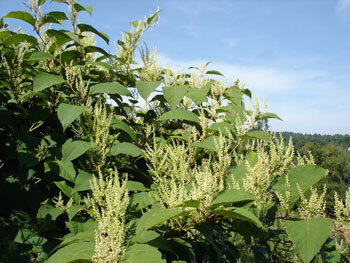
A very common statewide invasive is knotweed. Once planted as garden specimens and for erosion control, it is now seen frequently along roadsides. Once established, knotweed spreads quickly. When you spot it, control it. Learn more about knotweed and some of the people working to control it in this Deep Dive: Invasives article by Maine Public Reporter Patty Wight.
|
~ Jocelyn Hubbell, BPL Interpretive Specialist
Top of page

This small book makes a big statement. Award-winning author Barry Lopez asks us to take another look at our founding story, listen to others, and weave a new story that honors all of us and the place we call home.
The Wabanaki that live in Maine today now hold less than 1% of the land that once sustained their vital cultures. Can you imagine what this loss was like? What is it still like? And how much of their history, culture, and presence has been erased? Learn more.
~ Jocelyn Hubbell, BPL Interpretive Specialist
|

This lovely picture book pulls the reader gently into the story of Kunu?s first basket. It reveals a patient way of teaching and the special relationship between youth and elders as this traditional art is passed on to new generations of Penobscot. The illustrations by Susan Drucker are muted, emphasizing the calm way of being and doing even when Kunu is frustrated by his initial attempts at mastering all the steps of the basket-making process. Observant readers will notice the many types of traditional baskets and see what they were designed to carry. Children will delight in looking for and recognizing native plants and animals and spotting a pair of grey cats and a dog that appear on several of the pages.
~ Jocelyn Hubbell, BPL Interpretive Specialist
Top of page
|
Send article suggestions or newsletter comments to?Jocelyn Hubbell, Interpretive Specialist, webmaster, and newsletter editor for the Maine Bureau of Parks and Lands.
Read back issues of the newsletter.
|
